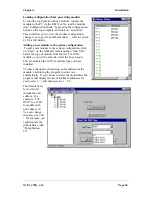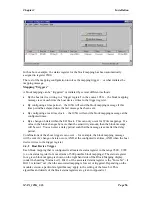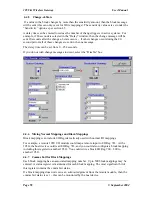
Chapter 3
Installation
MAN_105G_1.16
Page 56
In the above example, the status register for the block mapping has been automatically
assigned to register 9500.
The rest of the mapping configuration involves the mapping trigger - or what initiates the
mapping message.
Mapping “Triggers”
A block mapping can be “triggered” or initiated by several different methods.
•
By the host device writing to a “trigger register” in the source 105G - the block mapping
message is sent each time the host device writes to the trigger register.
•
By configuring a time period - the 105G will send the block mapping message if this
time period has elapsed since the last message has been sent.
•
By configuring a real-time clock - the 105G will send the block mapping message at the
configured times.
•
By a change-of-state within the I/O block. This can only occur for Write mappings. If a
value in the block changes by more than the sensitivity amount, then the block message
will be sent. You can enter a delay period such that the message is sent after the delay
period.
Combinations of the above triggers can occur - for example, the block mapping message
will be sent if a change-of-state occurs, AND at the configured real-time, AND when the host
device writes to the trigger register.
4.4.2
Host Device Trigger
Each block mapping that is configured is allocated a status register in the range 9500 – 9999
(i.e. one status register for a maximum of 500 possible block mappings). The status register
for a given block mapping is shown on the right hand side of the Block Mapping display
(under the heading “Status Lcn”). Bit 13 of the associated status register is the “Force bit” - if
Bit 13 is turned “on”, then the associated mapping is forced, or triggered. Depending on the
module version, a particular algorithm may apply to the setting of the force bit. This
algorithm and details of the block status registers are given in Appendix 1.
















































